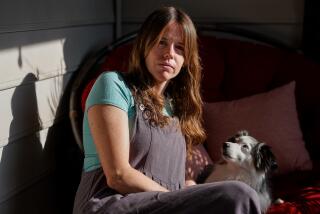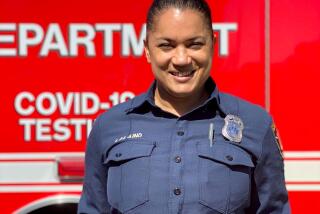‘Twilight Zone’ Expert on Explosives Will Testify
After 40 days of testimony from 48 prosecution witnesses, James Camomile, the special-effects technician who pulled the trigger that led to the deaths of actor Vic Morrow and two child actors, is finally scheduled to testify this week at the “Twilight Zone” involuntary manslaughter trial.
Camomile, who ignited the explosives that accidently knocked a helicopter from the sky and into the actors during the 1982 filming of a Vietnam War battle sequence, is considered a critical witness by both sides.
“After Camomile testifies,” said Deputy Dist. Atty. Lea Purwin D’Agostino, “you will really understand what happened on that set.” Defense attorney Arnold L. Klein, who represents special-effects coordinator Paul Stewart, puts it more dramatically: “I’d say James Camomile is going to make D’Agostino either a talk show guest or a deputy district attorney adjudicating juvenile cases for the rest of her life.”
Granted Immunity
Although Camomile will be called to the witness stand by the prosecution, which has granted him immunity, the defense insists that his testimony will expose fatal flaws in the prosecution case.
The tragedy was unforeseeable, the defense contends, because Camomile inadvertently fired his explosives before the helicopter was safely out of the way. Likely questions include whether the veteran technician looked up at the chopper’s position before firing and whether he mistakenly thought it was safe to ignite the mortars in the vicinity of the craft.
D’Agostino, on the other hand, maintains that Camomile’s testimony will serve as but one strong link in an inexorable chain of evidence dramatically demonstrating that director John Landis, Stewart and three associates acted negligently by placing the three actors in the vicinity of special-effects mortars and a low-flying helicopter.
“I think he’s a key witness, but not the key witness,” said D’Agostino, who asserted in an interview that she has already graphically shown a pattern of “carelessness, intimidation, lack of information to various people on the set as well as the fact that the defendants were on notice even before the children were hired that this was dangerous.”
As the trial drags in a snaillike fashion into its 12th week--D’Agostino is just past the halfway point in presenting witnesses--such evidence might seem a blur when mixed in with the cacophony of name-calling and a string of side issues that have often appeared to dominate the case.
Last week, for example, acrimony and admonishments concerning courtroom conduct continued unabated with D’Agostino and the defense sparring outside the jury’s presence. Landis, D’Agostino said, improperly smiled toward the jury during a witness’s testimony. Defense attorneys countered that the prosecutor repeatedly smirked at jurors during unfavorable cross-examination and they asked that her seat be moved to the far side of the courtroom.
Yet despite the histrionics, several key themes have thus far emerged as the prosecution presents its case. Among them:
- The fatal scene was not the subject of cautious or careful planning. One special-effects technician, Kevin Quibell, has testified that he never was given any information about what would happen during the filming. Another technician, Jerry Williams said that it was only a few minutes before the accident when special-effects coordinator Stewart took Camomile and him aside and told them not to fire their explosives until the helicopter was a safe distance away.
Industry Standards
Additionally, cameraman Michael Scott testified that during the only helicopter positioning rehearsal, held just 20 minutes before the fatal shot, his own camera did not seem to be positioned correctly. No full-scale test run with explosives was undertaken before the filming. Later witnesses are expected to testify on film industry standards for shooting special-effects sequences.
- Problems had arisen three hours earlier during the filming of another shot of the helicopter also involving explosives. In that shot, which did not include the two children, helicopter pilot Dorcey A. Wingo (a co-defendant) was singed by heat from a special-effects explosive.
Stunt coordinator Gary McLarty testified that he thereafter warned Landis that the final scene should be scaled down and that Landis “said it would be.” Yet although Landis proceeded to position the helicopter farther away from the fiery explosives, the explosions themselves were even larger in the fatal scene, according to several witnesses.
- The defendants received warnings beforehand that it might prove unsafe to use children in the final, and subsequently fatal, battle scene. Second assistant director Anderson House said he repeatedly expressed concerns to his superiors and even suggested using dummies rather than children. But defendant Dan Allingham, the unit production manager, told him the subject was “closed.”
Safety Doubts Told
As well, Marci Liroff, a casting director, testified that she told Landis that the scene “sounded kind of dangerous to me” when he described it to her more than a month before it was shot. Landis, she noted, gruffly replied, “The hell with you guys . . . we’ll get them off the streets ourselves,” when told it would be illegal to hire children for nighttime filming. - The children, Renee Chen, 6, and Myca Dinh Lee, 7, were indeed hired illegally. In fact, according to testimony from production secretary Donna Schuman, Landis and associate producer George Folsey Jr., a co-defendant, both joked about going to jail for illegally hiring the children.
Attorneys for Landis, Folsey and unit production manager Dan Allingham have indicated all along that their clients would have readily pleaded guilty to failing to apply for state work permits for children--but not to the crime they are instead charged with, involuntary manslaughter as a result of child endangerment.
The two sides have presented conflicting arguments about why the child work permits were not sought. The prosecution insists it was because the scene was potentially dangerous while the defense counters that the defendants correctly believed that such permits were not granted to youngsters for late-night shooting.
Called a Screamer
- Landis’ demeanor may have discouraged discussion about safety on the set. Several witnesses described Landis as a “yeller” and a “screamer,” with chief fire safety officer George Hull terming him “irrational.” In court by contrast, the 36-year-old director sports a trim beard and wire-rim glasses that lend him an almost professorial image.
D’Agostino, outside the presence of the jury, told the court that Hull went so far as to ask the assistant director whether Landis always acted like that and was informed, “Yes, he’s an artist.” Hull reportedly replied, “Bull . . . he’s crazy.” Even an insider like House testified that he never took his safety concerns directly to Landis because he “was intimidated.”
- The film makers may have been rushing to complete the final scene because they were running a day behind schedule. According to one witness, Landis ordered that live shotgun ammunition be used in a scene shot several days before the accident rather than wait an extra 15 minutes to prepare a special effect. The ammunition was not fired in the direction of any people, witnesses added.
The most gripping evidence that the prosecution has thus far shown, except perhaps for the tearful testimony of the children’s parents, is the film of the accident itself.
Death Scene
Shot from six different camera angles, the vivid footage does not graphically depict the actors’ deaths. Yet the searing, eerie images of a helicopter spinning crazily out of control toward Morrow and the children--with no further trace of them after the chopper finally comes to rest--is likely to leave an indelible impression on jurors’ minds.
“All you have to do is look at the film and you know,” D’Agostino said. “The film graphically demonstrates the violence. This was not an illusion. It was all too real. The magnitude of the explosions and fireballs constituted a firestorm.” She said it was not a scene in which to put human beings.
In coming weeks, D’Agostino plans to call still more of the 100-plus eyewitnesses, film industry experts and scientific experts to the stand. Testimony is expected to include opinions that the scene could have been filmed without using actors and explanations of what caused the helicopter to plunge into the actors.
Defense counsels, for their part, contend that the evidence thus far presented is not nearly enough to show that the crime of involuntary manslaughter was committed. In fact, they say, much of the prosecution evidence actually helps disprove gross negligence and child endangerment, which must be shown to establish the defendants’ guilt.
For example, while technician Williams said he considers special-effects explosions inherently dangerous, he also testified that he had deemed the fatal scene safe because of precautions that he and his co-workers took.
Fire Safety Officers
Along with double-edged testimony, the defense believes its case has been bolstered by other prosecution witnesses such as the six county fire safety officers on the set that night. None moved to shut the filming down, attorneys emphasize, although they had every right to if they felt the sequences were dangerous.
Moreover, the only firefighter who says he believed there was a safety problem, Richard Ebentheuer, acknowledged on the witness stand that he failed to present his concerns to the film makers before the accident occurred.
Finally, the defense is expected to make additional hay of a lingering dispute between D’Agostino and the former prosecutor on the case, Deputy Dist. Atty. Gary P. Kesselman, on the veracity of testimony by production secretary Schuman. Both prosecutors are likely to be called to testify in an effort by the defense to show prosecutorial misconduct in the handling of the case.
The defense has yet to indicate whether Landis or his four co-defendants will testify.
Whatever, more surprises are predictable, said Folsey’s attorney, Harland Braun, in a case that reminds him of “a trip through a sewer in a glass-bottomed boat.”
More to Read
Sign up for Essential California
The most important California stories and recommendations in your inbox every morning.
You may occasionally receive promotional content from the Los Angeles Times.










